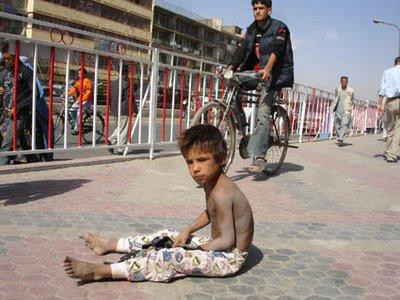Ali Ahmad, the sole breadwinner of an extended family in Kabul, has to decide whether to buy firewood to keep his children warm in winter or food to save them from hunger.

Afghans earn less than 30 USD per month.
“Everything is expensive… wheat flour, ghee, sugar, fuel and wood and I cannot afford them,” he complained.
A steady rise in food prices this year is posing serious risks for millions of Afghans who earn less than US$30 a month, aid agencies say.
The average wheat price in September was 7.3 percent higher than in August, and wheat prices in Afghanistan were “the highest in the region”, according to a UN World Food Programme (WFP) market price bulletin.
On 15 November in Kabul a 50kg sack of wheat flour was 1,190 Afghanis (US$26.50), and 16 litres of cooking oil 1,200 Afghanis (almost $27) - prices which, according to vendors, were higher than in September.
“Prices are going up steadily,” said Mohammad Zahir, a vendor in Kabul, adding that they would increase further in winter.
Food prices are, however, markedly lower than during the global crisis in 2008, which pushed 4.5 million Afghans into high-risk food insecurity.
Afghanistan is expecting a good harvest this year but there is likely to be a deficit of at least 700,000 tons of wheat in 2010 which is expected to be met in part by wheat imports from Kazakhstan.
Protracted crisis
Afghanistan is among 22 protracted emergencies in the world “which are facing enormous challenges like repeated food crises and an extremely high prevalence of hunger due to a combination of natural disasters, conflict and weak institutions,” the UN Food and Agriculture Organization (FAO) said in its October report entitled State of Food Insecurity in the World.
A protracted food insecurity crisis can become a self-perpetuating vicious circle and pose serious threats to both lives and livelihoods, from which recovery may become more difficult over time, FAO said.
Over half of Afghanistan will face moderate or high-level food insecurity in the next three months, the US Famine Early Warning System Network, said.
At least nine million Afghans (36 percent of the population) live in absolute poverty, and five million “non-poor” live on 2,100 Afghanis (US$43) a month, according to a 2008 National Risk and Vulnerability Assessment.
The government, backed by foreign aid agencies, said it would assist vulnerable households with free food rations, and imports of wheat flour from India and Kazakhstan to stabilize market prices.
Pakistan flood impact
This year’s catastrophic floods in Pakistan have seriously damaged agriculture, causing food prices to rise sharply and the government to impose a ban on most food exports. Traditionally Afghanistan has relied on food imports from Pakistan. This year the government plans to import about 250,000 tons of wheat from India.
“Over 50,000 tons of Afghan food imports have been stopped in Pakistan’s Karachi city and we have been unable to meet market needs,” Khan Jan Alkozai, an official from the traders’ union, told IRIN, pointing out that imports from Central Asia and Iran were both more difficult and expensive than Pakistan.
Under US auspices, Afghanistan and Pakistan signed a new trade and transit agreement in October (after 44 years of negotiations) which promises free transit facilities for traders from both countries.
But convoys on the Afghanistan-Pakistan highway have frequently been torched, and the new agreement faces numerous bureaucratic hurdles in both countries, according to Alkozai - all of which bodes ill for families like Ali Ahmad’s who will struggle to survive this winter.



